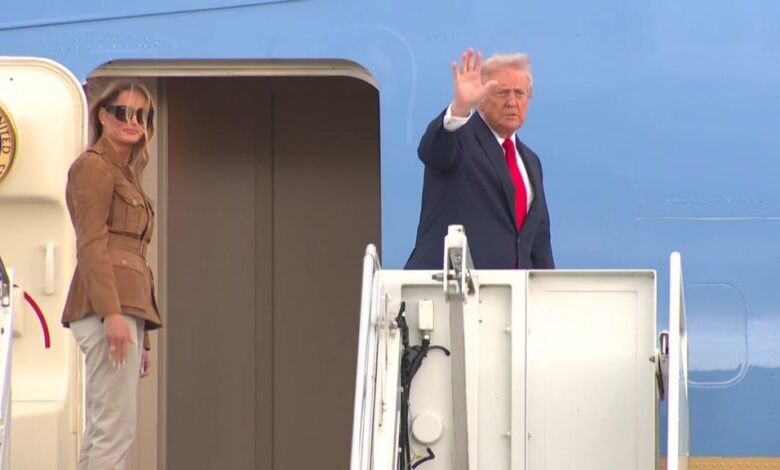Donald Trump and First Lady Melania depart UK as state visit ends

Donald Trump’s second state visit to the United Kingdom has drawn to a close, with the president and First Lady Melania Trump boarding Air Force One at London Stansted Airport to return to the United States. The visit was a mixture of ceremony, political negotiations, and headline-grabbing moments, leaving behind a trail of both controversy and cautious diplomatic progress.
The trip was marked by its mix of grandeur and unpredictability. From the formal state banquet to press conferences where Trump veered between blunt criticism and diplomatic restraint, the visit underlined the unusual but functioning relationship between Trump and Prime Minister Keir Starmer. The two leaders spoke at Chequers, the historic prime ministerial retreat that has hosted figures from Winston Churchill to Bill Clinton. Despite their contrasting political instincts and styles, Starmer managed to establish a tone of mutual respect, at least publicly, keeping Trump’s more volatile tendencies in check. Observers noted that the visit provided the UK with valuable “face time” with the American president, though it is far less clear whether Britain managed to shift the White House on substantive issues.
At their joint press conference, Trump offered pointed remarks on a range of subjects. On immigration, he suggested that Britain could involve the military in tackling the small boat crisis, saying the government should not hesitate to use any means necessary. Starmer, by contrast, defended his existing approach, citing new agreements with France and the recent deportation of a Channel migrant as evidence his policy was working. The exchange highlighted their different instincts, though Trump’s comments were delivered with less aggression than in past encounters.
On international conflicts, both leaders struck common ground and sharp differences. Regarding the war in Gaza, Trump and Starmer agreed on the urgent need for Hamas to release hostages and for humanitarian aid to reach civilians. But Trump drew a red line at Starmer’s stated plan to recognise a Palestinian state, calling it a point of disagreement with the prime minister. On Ukraine, Trump admitted Vladimir Putin had “let him down,” lamenting what he once thought would be an easier conflict to resolve. He did not, however, retract his decision to hold a peace summit with Putin in Alaska earlier in the year. Starmer, for his part, stressed that Putin’s actions showed no genuine interest in peace and pressed for stronger international pressure on Moscow.
Another recurring theme of the visit was Trump’s ability to sidestep potential controversies. When asked about Lord Peter Mandelson, recently dismissed as Britain’s ambassador to Washington after revelations of ties to Jeffrey Epstein, Trump insisted he did not know him. Yet photographs place the two together as recently as September. Analysts saw Trump’s denial as a calculated move to avoid becoming entangled in a scandal not of his making. Similarly, when questioned about Epstein himself, Trump pivoted swiftly, a tactic he has used repeatedly to avoid deeper scrutiny.
The visit also touched on domestic American matters. Trump paid tribute to the recently slain right-wing activist Charlie Kirk, calling his death an assassination for speaking his mind, and even suggesting Kirk might have had a shot at the presidency one day. When asked about talk show host Jimmy Kimmel, suspended after controversial remarks about Kirk, Trump dismissed him as talentless and suffering from poor ratings. These comments added a distinctly American flavour to what was otherwise a diplomatically focused trip.
Royal protocol also became a talking point after Trump was filmed walking slightly ahead of King Charles and placing his hand on the monarch’s back. Critics on social media accused him of breaking protocol, but experts were quick to explain that such rules are unwritten and flexible. King Charles himself appeared to invite Trump to walk ahead, as he has done with other world leaders, making the gesture more a matter of optics than disrespect.
For Downing Street, the visit was considered a success. Trump’s disagreements with Starmer on Palestine, immigration, and energy were handled civilly, with Trump framing them as polite differences rather than confrontations. More contentious issues like Epstein or Nigel Farage never dominated the conversation, and the UK emerged from the visit without any major diplomatic bruises. Analysts even suggested Starmer had achieved the rare feat of making Trump appear subdued, perhaps even dull, in front of the cameras.
As Air Force One lifted off from Stansted, the symbolism was clear. Britain had hosted a president known for his unpredictability and survived the visit not only intact but with strengthened personal ties between the two leaders. Yet the deeper question remains unresolved: whether Britain succeeded in nudging American policy in any meaningful way. On Ukraine, Gaza, and broader foreign policy, Trump gave little sign of changing course. What Starmer did achieve was keeping the relationship warm, pragmatic, and publicly respectful—a necessary foundation for a future partnership, even if it falls short of shifting the White House.
In the end, this state visit was a diplomatic cocktail of ceremony, cautious negotiation, and spectacle. It offered moments of tension and flashes of unpredictability, but avoided outright disaster. For Number 10, that alone is a win worth noting.